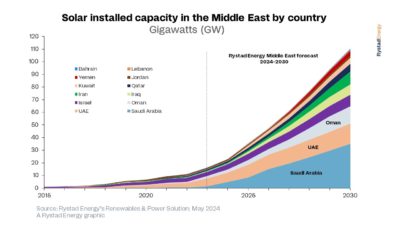The total solar capacity in the Middle East at the end of 2023 exceeded 16 GW and is expected to approach 23 GW by the end of 2024. Projections indicate that by 2030, the capacity will surpass 100 GW, with green hydrogen projects contributing to an annual growth rate of 30%.
According to a recent report by Rystad Energy,
“Renewables capacity in the Middle East is set to soar in the coming years, with green energy sources outpacing fossil fuel usage in the power sector by 2040, according to Rystad Energy’s latest research. Solar photovoltaic (PV) is expected to emerge as the predominant source, accounting for more than half of the region’s power supply by the middle of the century, up from 2% last year. By 2050, renewable energy sources, including hydro in addition to solar and wind, are expected to constitute a staggering 70% of the Middle East’s power generation mix. This marks a monumental leap from the mere 5% recorded at the end of 2023, signaling a transformative shift in the region’s energy landscape.”
Noting that the Middle East’s energy sector is at a ‘turning point’ and traditionally reliant on oil and gas, “the region is shifting its focus to renewables as a response to rapid industrial growth, increasing population, and a global drive to reduce carbon emissions. The region is home to over 280 million people and has one of the world’s fastest-growing populations, increasing by over 60% since 2000. This has led to a rapid increase in power demand, more than doubling in the past 20 years.”

To read more, click here, here and here.









